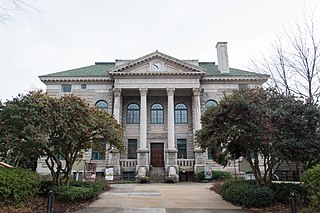
Decatur is a city in, and the county seat of, DeKalb County, Georgia, United States, part of the Atlanta metropolitan area. With a population of 24,928 in the 2020 census, the municipality is sometimes assumed to be larger since multiple ZIP Codes in unincorporated DeKalb County bear Decatur as the address. The city is served by three MARTA rail stations. The city is located approximately five miles northeast of Downtown Atlanta and shares its western border with both the city of Atlanta and unincorporated DeKalb County. The Druid Hills neighborhood is to the northwest of Decatur.

Madison is a city in Morgan County, Georgia, United States. It is part of the Atlanta-Athens-Clarke-Sandy Springs Combined Statistical Area. The population was 4,447 at the 2020 census, up from 3,979 in 2010. The city is the county seat of Morgan County and the site of the Morgan County Courthouse.

Dallas is a city in, and the county seat of, Paulding County, Georgia, United States. The estimated population, as of 2020, was 14,042. Dallas is a northwestern exurb of Atlanta, located approximately 38 miles (61 km) from the downtown area. It was named for George M. Dallas, Vice President of the United States, under James K. Polk.
The Battle of Lovejoy's Station was fought on August 20, 1864, near what is now Lovejoy, Georgia, in Clayton County, during the Atlanta Campaign of the American Civil War. The two sides had arrived at something of a stalemate, with the Union army half-encircling Atlanta and the Confederate defenders staying behind their fortifications.

Oakland Cemetery is one of the largest cemetery green spaces in Atlanta, Georgia, U.S. Founded as Atlanta Cemetery in 1850 on six acres (2.4 hectares) of land southeast of the city, it was renamed in 1872 to reflect the large number of oak and magnolia trees growing in the area. By that time, the city had grown and the cemetery had enlarged correspondingly to the current 48 acres (190,000 m2). Since then, Atlanta has continued to expand so that the cemetery is now located in the center of the city. Oakland is an excellent example of a Victorian-style cemetery, and reflects the "garden cemetery" movement started and exemplified by Mount Auburn Cemetery in Massachusetts.
Historic ferries operated on rivers around Atlanta, Georgia area, and became namesakes for numerous current-day roads in north Georgia. Most of the ferries date to the early years of European-American settlement in the 1820s and 1830s, when parts of the region were still occupied by cherokee and other Native American communities.

New Echota was the capital of the Cherokee Nation in the Southeast United States from 1825 until their forced removal in the late 1830s. New Echota is located in present-day Gordon County, in northwest Georgia, 3.68 miles north of Calhoun. It is south of Resaca, next to present day New Town, known to the Cherokee as Ꭴꮝꮤꮎꮅ, Ustanali. The site has been preserved as a state park and a historic site. It was designated in 1973 as a National Historic Landmark District.

Sautee Nacoochee is a census-designated place in White County, Georgia, United States, near Sautee Creek in the Appalachian foothills of northeast Georgia, approximately 95 miles (153 km) north of Atlanta. The nearest incorporated town is the tourist destination of Helen.

A commemorative plaque, or simply plaque, or in other places referred to as a historical marker, historic marker, or historic plaque, is a plate of metal, ceramic, stone, wood, or other material, typically attached to a wall, stone, or other vertical surface, and bearing text or an image in relief, or both, to commemorate one or more persons, an event, a former use of the place, or some other thing. Many modern plaques and markers are used to associate the location where the plaque or marker is installed with the person, event, or item commemorated as a place worthy of visit. A monumental plaque or tablet commemorating a deceased person or persons, can be a simple form of church monument. Most modern plaques affixed in this way are commemorative of something, but this is not always the case, and there are purely religious plaques, or those signifying ownership or affiliation of some sort. A plaquette is a small plaque, but in English, unlike many European languages, the term is not typically used for outdoor plaques fixed to walls.

The Texas Historical Commission is an agency dedicated to historic preservation within the U.S. state of Texas. It administers the National Register of Historic Places for sites in Texas.

Samuel Austin Worcester, was an American missionary to the Cherokee, translator of the Bible, printer, and defender of the Cherokee sovereignty. He collaborated with Elias Boudinot (Cherokee) in Georgia to establish the Cherokee Phoenix, the first Native American newspaper, which was printed in both English and the Cherokee syllabary. The Cherokee gave Worcester the honorary name A-tse-nu-sti, which translates to "messenger" in English.

The boundary markers of the original District of Columbia are the 40 milestones that marked the four lines forming the boundaries between the states of Maryland and Virginia and the square of 100 square miles (259 km2) of federal territory that became the District of Columbia in 1801. Working under the supervision of three commissioners that President George Washington had appointed in 1790 in accordance with the federal Residence Act, a surveying team led by Major Andrew Ellicott placed these markers in 1791 and 1792. Among Ellicott's assistants were his brothers Joseph and Benjamin Ellicott, Isaac Roberdeau, George Fenwick, Isaac Briggs and an African American astronomer, Benjamin Banneker.

The Georgia Historical Society (GHS) is a statewide historical society in Georgia. Headquartered in Savannah, Georgia, GHS is one of the oldest historical organizations in the United States. Since 1839, the society has collected, examined, and taught Georgia history through a variety of educational outreach programs, publications, and research services.

Red Clay State Historic Park is a state park located in southern Bradley County, Tennessee, United States. The park preserves the Red Clay Council Grounds, which were the site of the last capital of the Cherokee Nation in the eastern United States from 1832 to 1838 before the enforcement of the Indian Removal Act of 1830. This act resulted in a forced migration of most of the Cherokee people to present-day Oklahoma known as the Cherokee removal. At the council grounds, the Cherokee made multiple unsuccessful pleas to the U.S. government to be allowed to remain in their ancestral homeland. The site is considered sacred to the Cherokees, and includes the Blue Hole Spring, a large hydrological spring. It is also listed as an interpretive center along the Trail of Tears National Historic Trail.
The Tennessee Historical Commission (THC) is the State Historic Preservation Office for the U.S. state of Tennessee. Headquartered in Nashville, it is an independent state agency, administratively attached to the Department of Environment and Conservation. Its mission is to protect, preserve, interpret, maintain, and administer historic places; to encourage the inclusive diverse study of Tennessee's history for the benefit of future generations; to mark important locations, persons, and events in Tennessee history; to assist in worthy publication projects; to review, comment on and identify projects that will potentially impact historic properties; to locate, identify, record, and nominate to the National Register of Historic Places all properties which meet National Register criteria, and to implement other programs of the National Historic Preservation Act of 1966 as amended. The Tennessee Historical Commission also refers to the entity consisting of 24 Governor-appointed members and five ex officio members.

The commemoration of the American Civil War is based on the memories of the Civil War that Americans have shaped according to their political, social and cultural circumstances and needs, starting with the Gettysburg Address and the dedication of the Gettysburg cemetery in 1863. Confederates, both veterans and women, were especially active in forging the myth of the Lost Cause of the Confederacy.
A Historic marker is an "Alamo"-shaped plaque affixed to the top of a pole and erected next to a significant historic site, battlefield or county courthouse. In the state of Georgia there are roughly 2,000 historic markers. Kevin Levin of the Smithsonian magazine said of the erected signs, "Historical markers are a ubiquitous presence along many of the nation's highways and country roads. You can spot their distinctive lettering, background color, and shape without even realizing what they commemorate."
Mary Gregory Jewett was an American preservationist, journalist, public official, and historian who ran the Georgia Historical Commission from 1960 through its dissolution in 1973, and served as the first president of the Georgia Trust for Historic Preservation. In 2013, she was posthumously named a Georgia Woman of Achievement.

The Illinois Monument is a public monument located in the Kennesaw Mountain National Battlefield Park in Cobb County, Georgia, United States. The monument honors the soldiers from Illinois who fought in the Battle of Kennesaw Mountain during the Atlanta campaign of the American Civil War. It is located on Cheatham Hill, the site of intense fighting during the battle, and was dedicated in 1914, on the 50th anniversary of the battle. It was designed by Mario Korbel and James Dibelka.
West Virginia Archives and History is the state agency that collects and preserves materials on the state and makes them available to the public. Located in Charleston, West Virginia, this section of the Department of Arts, Culture and History oversees the West Virginia Archives and History Library, a non-lending research facility, and the West Virginia State Archives, one of the state’s most important repositories on the history of West Virginia and its residents. As of 2019, the agency held more than 16,000 linear feet of manuscripts and state government archives; 1,000,000 photographs, negatives, slides, and digital images; 76,000 books, 33,000 microfilms, 100,000 film stories and video tapes, as well as thousands of maps, state documents, and periodicals. The section currently subscribes to about six dozen West Virginia newspapers.















